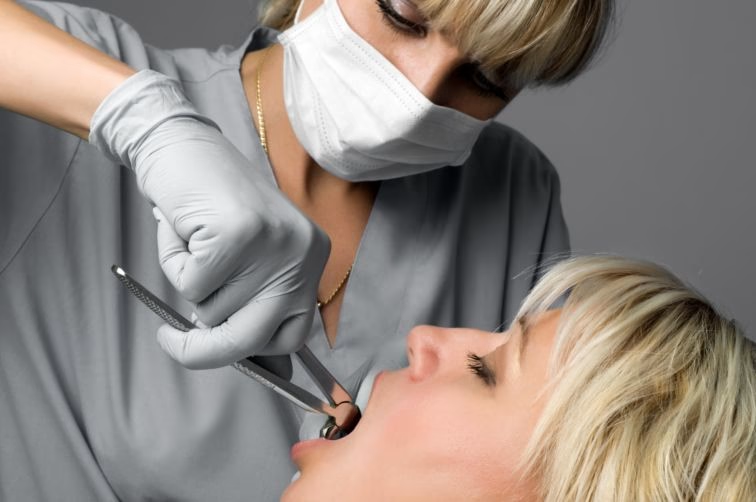Dry Socket Pain: What Are the Causes and How to Deal With It
31 March 2021 | Updated: 6 November 2025

Sometimes, no matter how skilled your dentist is, a damaged tooth simply can’t be saved and must be removed. After the extraction, there’s usually a bit of soreness and an empty space where the tooth used to be and then it’s just a matter of waiting for the area to heal.
Normally, a blood clot forms in the socket to protect the exposed bone and nerves, helping the gum tissue recover and preventing infection. However, when this doesn’t happen, or if the clot becomes dislodged, a painful condition known as a dry socket can develop. You can often spot it by looking at the extraction site – if the blood clot is missing and the jawbone is visible, it’s likely a dry socket.
Dry sockets can be painful and can, if left untreated, lead to some unpleasant side effects. A dry socket pain doesn’t always begin right away. It can take several days before the pain begins. Most of the time, the pain starts small and gradually gets worse over time. Other times the pain can begin without warning and can be excruciating in which case you should seek an emergency dentist immediately.
In this article, we’ll explore what causes a dry socket, how to recognise the symptoms, and the most effective treatments to relieve the pain and promote healing.
What Causes Dry Socket?
Even with all the modern medicine and advancements made in dental science, it’s still not clear what is the exact cause of dry socket.
Experts believe that dry socket is more common with people who:
- Smoke cigarettes
- Chew tobacco
- Take birth control pills
- Have had a dry socket before
It is also believed that people who take poor care of their dental health are more likely to experience dry socket.
What Are the Risk Factors?

When a tooth is extracted, it’s not uncommon to experience some mild pain at the extraction site.
The same rules apply to dry sockets, however, the pain tends to get worse if left untreated. It is also possible to have a dry socket and not experience any pain at all, at first. The pain caused by dry socket can start to emerge a few days after the extraction.
Other than pain, an unattended dry socket can also lead to:
- Bad breath
- Bad taste in the mouth
- Gum and mouth infections
- Visible bone at the extraction site
How to Treat Dry Socket
The good news is that a dry socket is a temporary condition when treated promptly and correctly. While a blood clot may not form immediately after a tooth extraction, with proper care, the healing process will gradually begin.
Unlike bleeding gums, a dry socket doesn’t usually show visible signs of blood. Instead, your dentist will start by carefully cleaning the affected area, removing any trapped food particles or debris.
Next, a protective gauze or medicated gel (dressing) will be placed inside the socket to shield it from bacteria and irritation. Your dentist will also provide detailed instructions on what to avoid and how to care for the area until the tissue heals completely.
If the pain is more intense, over-the-counter pain relief medication can help manage discomfort. In more severe cases, your dentist may instruct you on how to replace the dressing at home and continue treatment safely until the socket closes and healing is complete.
How to Prevent Dry Socket

There are several simple steps you can take to reduce the risk of developing a dry socket after a tooth extraction.
In the days leading up to your procedure, it’s important to:
- Avoid smoking or using tobacco products.
- Stop chewing tobacco, as it can interfere with healing.
- Consult your dentist about any medications you’re taking, especially blood thinners that may prevent proper clot formation.
Always ensure that your tooth extraction is performed by a qualified dentist. Choosing an experienced professional significantly lowers the risk of complications, including dry socket.
After the procedure, follow your dentist’s instructions closely and maintain proper oral hygiene to protect the extraction site. You should:
- Have your dentist place a protective gauze or medicated gel on the treated area.
- Rinse gently with an antibacterial mouthwash or prescribed oral gel.
- Rest properly after your tooth extraction surgery
Even with all precautions, a dry socket can sometimes occur. Fortunately, it’s a temporary condition that can be effectively treated with the right care and professional support.
How to Prevent Dry Socket
If you’re planning a tooth extraction or are concerned about dry socket, MGA Dental is your trusted clinics for expert, pain-free dental care. Our experienced team provides safe extractions, thorough aftercare, and effective dry socket treatment to ensure a smooth and comfortable recovery.
Book your appointment today at MGA Dental Gold Coast or Brisbane – your go-to dental clinics for extractions, aftercare, and complete peace of mind.











